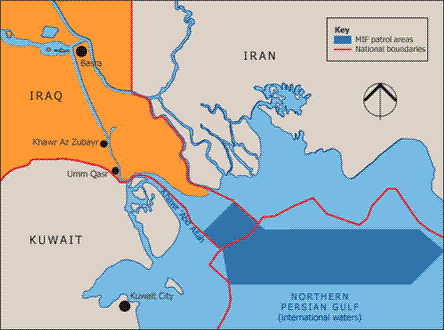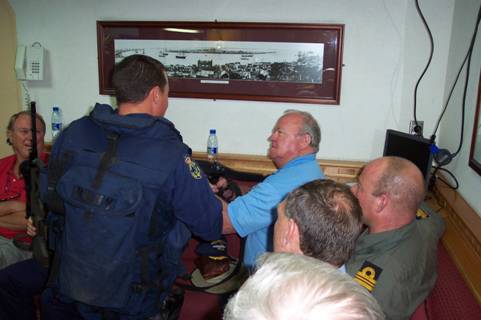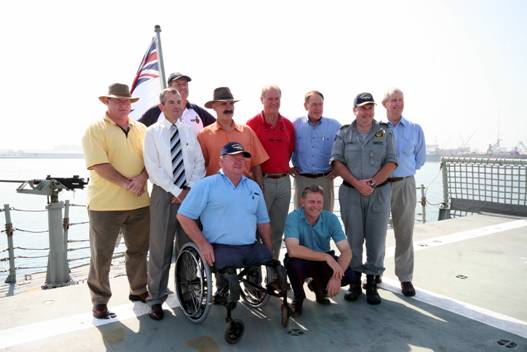Background |
| 3.1 |
The Royal Australian Navy (RAN) has considerable experience of operations in the northern Arabian Gulf. Since 1990, the RAN has regularly provided ships to the multinational Maritime Interception Force (MIF), enforcing UN sanctions on Iraqi trade through the Persian Gulf (and at times in the Red Sea). |
| 3.2 |
The RAN presence in the first Gulf War included two frigates and the replenishment ship HMAS Success, which, having no air defences of its own, relied on the army's 16th Air Defence Regiment. In January 1991 the replenishment tanker HMAS Westralia left Fremantle to relieve Success. Four warships, HMAS Sydney (IV), HMAS Adelaide, HMAS Brisbane and HMAS Darwin also served tours of duty in the Persian Gulf. During the operational phase of their deployment they formed part of the anti-aircraft screen for the carrier battle groups of the US Navy. A RAN clearance diving team was also dispatched for explosive ordnance and demolition tasks. |
| 3.3 |
The RAN continued to rotate ships through the gulf as part of sanction enforcement for much of the period between the 1991 conflict and the terrorist attacks in the US in 2001. |
| 3.4 |
Before and after 11 September 2001, the MIF, led by Australian frigate HMAS Anzac, worked hard to tighten the blockade and stem the flow of smuggled oil coming out of Iraq. Enjoying robust rules of engagement, and able to operate in shallow waters, Anzac undertook night operations to intercept smugglers close to the mouth of the Khawr ’ Abd Allah waterway. |
| 3.5 |
After September 2001, the Australian presence in the MIF was increased to three ships. Since then Australians have regularly commanded the multinational operation, the first time the MIF has had non-American command. By 2003 the smuggling of oil (and dates, another lucrative cargo) had been largely curtailed. |
| 3.6 |
During the Second Gulf War, Australian Captain Peter Jones commanded coalition naval operations in the northern Persian Gulf. Operations included surveillance and inspection of all shipping in the area, clearing the Khawr ’ Abd Allah waterway, and naval gunfire support by HMAS Anzac in support of British forces ashore. In a notable success, coalition boarding parties based in HMAS Kanimbla seized three tugs and a barge preparing to lay sea-mines to attack coalition shipping.1 |
|
|
Current Operations |
Naval Capability |
| 3.7 |
The delegation visited the Australian Navy ship currently assigned as Australia’s contribution to the coalition naval task force, HMAS Newcastle. The ship, nearing the end of a six month operational tour in the Middle East Area of Operations, was conducting maintenance in Port Rashid Dubai, in preparation for its return voyage to Australia. |
| 3.8 |
HMAS Newcastle is a Guided Missile Frigate easily suited to its task in the Gulf. She was designed as a long range naval escort ship with roles including area air defence, anti-submarine warfare, surveillance, reconnaissance and interdiction. The ship is capable of countering simultaneous threats from the air, surface and sub-surface. These capabilities enabled the Captain and crew to monitor the dense picture of surface activity in the waterways of the northern Gulf and to liaise and track coalition surveillance aircraft, including Australia’s P3C Orions. Newcastle is powered by modern gas turbine engines and two forward mounted retractable auxiliary propulsion units, making the ship fast and extremely manoeuvrable in the confined waters. |
| 3.9 |
HMAS Newcastle is armed with surface-to-air missiles and the Harpoon anti-ship missile. The ship is also equipped with a 76mm gun, a close protection weapon-system, and can launch torpedos. To extend the reach of the ship it is equipped with a flight deck and two helicopter hangars
capable of housing S-70B-2 Seahawk Helicopters, though only a single Seahawk was deployed to the Gulf. The ships sensor package includes long range radars for air and surface surveillance and Forward Looking Infra Red (FLIR) sights capable of surveillance in low light or poor weather conditions. |
| 3.10 |
Newcastle is also equipped for the current deployment with two Rigid Hull Inflatable Boats (RHIBs) and has two dedicated boarding parties. These boarding parties were critical to the success of Newcastle’s mission, providing the human element to security operations involving boats and trade that pre-date modern technology.
|
|

Source http://www.navy.gov.au/ships/newcastle/default.htm |
|
|
Visit Conduct |
| 3.11 |
On arrival aboard the HMAS Newcastle the delegation was met by the ship’s captain, Captain Trevor Jones. The delegation received a comprehensive series of briefs as follows:
- A classified brief on the day to day methods used by the ship to achieve its mission of protecting the Iraqi oil infrastructure. The brief also covered the operation of smugglers, pirates and patrol and boarding operations.
- An intelligence briefing on the risks posed by Ant-Coalition elements and the motivation of other risk groups in the area.
- A brief by the leader of the ship’s boarding parties. The briefing demonstrated the quality of the young service people who are at the forefront of the ship’s interaction with the people of the Gulf.
- The operations officer then escorted the delegation for a detailed tour of the ship.
|
|
|
Task and Threats Faced |
| 3.12 |
Captain Jones and some of his key staff described the tactics and techniques used by the Maritime Interdiction Force to police sea-borne traffic in the Gulf. This report will not discuss the specifics of the techniques used to achieve the demanding mission but will comment on the demands placed on the ship and its crew. |
| 3.13 |
HMAS Newcastle had conducted four 30 day patrols in the shallow waters at the northern extremity of the Arabian Gulf. The primary task undertaken during these patrols was the protection of Iraq’s Gulf Oil Platforms. These terminals are used to load much of Iraq’s export oil onto international vessels so are key to current and future prosperity of Iraq. The Australian Naval patrols were conducted amidst hundreds of local craft, many of which were legitimately conducting the trade that has sustained the region for many hundreds of years. Some of this traffic however has quite different motivation.
|
|

Source http://www.awm.gov.au/iraq/ran.asp |
| 3.14 |
In 2004 a US ship, the USS Firebolt, operating in the same area patrolled by HMAS Newcastle, suffered three sailors killed when a suicide vessel exploded as a boarding party from the ship approached the unidentified dhow for inspection. As the seven-member boarding team approached the dhow in their RHIB, the dhow exploded, killing the two sailors and tossing the rest of the boarding team - three sailors and two coast guardsmen - into the water. A third member died later of wounds. |
| 3.15 |
Captain Jones briefed the delegation on the demands faced by the crew as a result of such enemy suicide tactics. He and his crew faced uncertainty every time a boarding party left the ship to investigate local craft or when the ship itself manoeuvred to block the approach of vessels seeking to move close to the Gulf Oil Platforms. The threat from such attacks is not trivial, even in a ship as capable as the Newcastle. The effective destruction of the USS Cole by suicide attack using small craft in Yemen in September 2000 gives an indication of the dangers facing our sailors in such situations.
|
 |
|
|
International Sensitivities |
| 3.16 |
Captain Jones also briefed the delegation on the issues associated with operating within metres of the maritime border between Iraq and Iran. This border has been the source of significant dispute between Iraq and Iran, much of which is unresolved. The Captain briefed that the RAN has no interest in causing an international incident with the Iranian Navy, but at the same time has a responsibility to maintain the territorial integrity of the newly democratic Iraq. In this sensitive climate, where individual actions can have significant strategic consequences the delegation was briefed that the Australian Naval officers and sailors had operated with great restraint and sensitivity, easing tensions in a number of explosive situations. |
| 3.17 |
The delegation was also briefed on the progress being made developing the new Iraqi Navy. British and Australian training and ongoing British mentoring have produced a small patrol boat force. The force is slowly developing the type of crew cohesion taken for granted in the UK and Australia but many challenges remain. The equipment being operated by the Iraqi Navy varies in standard from reasonably capable to dilapidated, which in turn means equipment availability rates are low. The type of vessels selected for the force is appropriate for the security tasks required of a defensive Iraqi Navy in the northern Gulf. However, despite the skill of many individual Iraqi sailors it will be some time before the Iraqi Navy can police the area independent of supporting coalition assets. In the current phase of security transition the coalition Navies provide logistic and maintenance support for the Iraqi patrol boats and mentoring for the Iraqi Naval planners and leaders. |
|
|
Conclusion |
| 3.18 |
HMAS Newcastle represents a long line of RAN vessels and their crews that have contributed to the security of this critical region. Like those before, the ship and its crew have excelled in this demanding environment. The delegation members were delighted to be able to visit the ship close to the end of a demanding tour to thank the officers and crew for their efforts. |
| 3.19 |
The delegation made the following observations during the visit:
- The Newcastle and her predecessors are making a very substantial contribution to the rehabilitation of Iraq by guarding infrastructure critical to the economic prosperity of the nation and reducing criminal activity that could be used to support terror groups in Iraq.
- The delegation observed that relatively junior members of the Navy are conducting boarding operations, which are often dangerous and sensitive tasks, with great skill, compassion and restraint. They have done this repeatedly with great success. While the technology embedded in the ship is sophisticated it cannot determine the motivation of the crewmen aboard hundreds of local dhows. To test the motivation of local seamen and to ensure the coalition message deterring illegal activity is passed effectively, groups of young Australian’s must repeatedly board these vessels. They are doing this in the face of significant threat and the risk of international incidents with a sensitive neighbour with mature awareness of the consequences of their actions, bringing great credit to themselves and to Australia.
- All the RAN personnel met by the delegation demonstrated a strong commitment to their task and high morale. They had no major complaints and were happy with the logistic and administrative support for their deployment.
- The delegation was impressed by the willingness of the ship’s crew to contribute to the operation at many levels, beyond that expected in more routine circumstances. For example the ship had been responsible for feeding the coalition personnel embarked on the oil platforms. This involved significant effort in preparing and delivering three meals per day during all weather and under the pressure of numerous other tasks.
|
 |